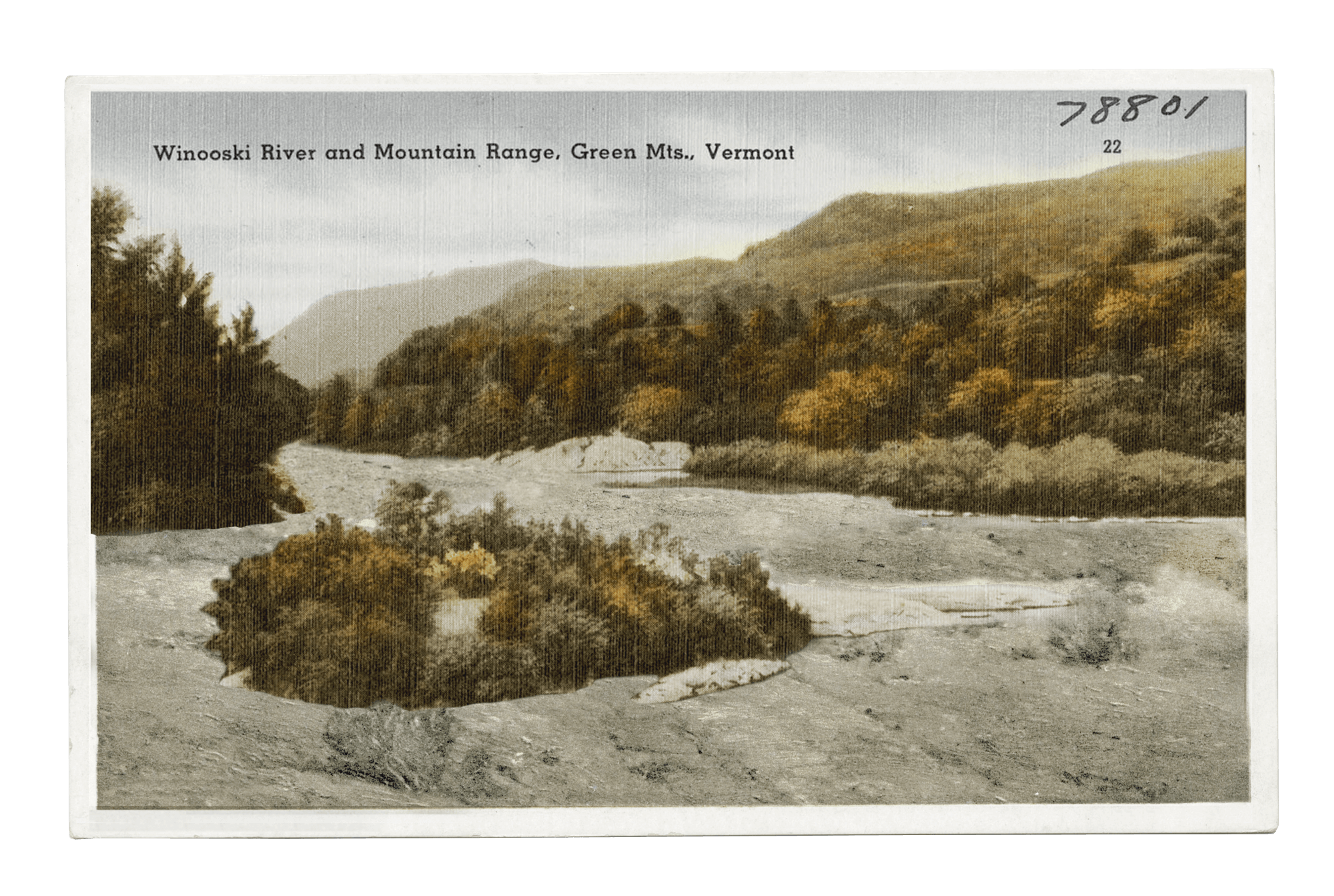As Vermont farmers and ranchers head into winter after three years of weather catastrophes, they’re looking for emergency funding, better on-farm resilience — and whatever hay you can spare.
The only hint that something was amiss came from the leaves: muted yellows and browns instead of the usual flame tones of a crisp Vermont autumn afternoon. That is, until you started talking to farmers.
Sighing deeply between sentences, they connected the dots between the vaguely un-vibrant trees and the catastrophe brewing across their acreages: drought, which began this June and, as it evolved over the summer and into the fall, shriveled grass pastures and taxed wells and waterways. As of this writing, more than half the state had finally emerged from drought and the effects of too many months with too little water, down from 89 percent just a few days earlier, in mid-November.
“We can count on a six-week period, usually by August, that’s going to be dry — it’s pretty consistent,” said Ben Haigh, who owns a direct-to-consumer beef, lamb and butter operation called Rolling Bale Farm in Shoreham, in the Champlain Valley. “This year was different, because all the plants just completely went dormant and everything was brown. We’re used to periods of reduced growth. We’re just not used to this whole no growth.”
Heading into winter with too little feed for their animals, over 160 producers have so far reported more than 65,000 acres affected — one quarter “severely” — with $16.5 million in estimated losses. Thirty-one percent foretold poor, severe, or critical financial health for the coming year. The state appealed to the feds for a disaster designation in early October but due to the government shutdown, any potential aid was likely to be “too late for some farmers,” according to Valley News.
Not that Haigh was holding out much hope for federal relief: “You have to get presidential approval on those designations and Trump is not a fan of Vermont,” he said, referencing the president’s refusal to release aid in response to flooding earlier this summer — the third consecutive year in which severe rainstorms washed out portions of the state.
This August in Vermont was the driest there since 1895 but it’s also these extreme swings in weather, from severely dry to overwhelmingly wet, that are harbingers of a more challenging farming future under climate change. Such swings are also causing corn yields to drop in North Carolina, and soybeans and other crops to falter in Minnesota and Iowa.
“If this happens again next year, we are done if we don’t make any changes.”
Jamie Hamilton, a first-generation grassfed-and-finished beef producer in Western Vermont, walked Offrange through the unusual and devastating effects of weather on his operation — recounting a series of events echoed by many other local livestock farmers: “It rained fairly regularly through May and into early June, and that prevented us from getting our first-cut hay off in a timely manner,” he said.
The rain also compelled him to keep his 400 head of cattle off pasture in those months, to avoid them destroying the muddy fields; supplementally feeding them during that time was an unexpected expense. “Then the water just shut off, and it didn’t come back on until” mid-October, Hamilton said. “By the time that we had enough dry weather to get the hay off, the heat and drought kicked in.” The hay grew back poorly after it was first cut, which meant when it was cut for the second time later in summer, “We ran about a 30 percent yield … compared to what we normally do, which is brutal.”
Recognizing the pending emergency, Hamilton started buying up feed here and there from hay farmers “kind of early,” he said. But as he’d also had to supplementally feed in the early fall to try to give his parched and stunted fields a chance to bounce back, he’s still short about 100 round bales. (He feeds 10 to 12 of these a day throughout the winter.) With every other livestock farmer in Vermont in pretty much the same boat, he said, “Getting quality hay is going to be the biggest challenge.”
Diversified farmers like Margaret Loftus, who raises vegetables and poultry, pigs, sheep, and cattle in West Corinth, near the New Hampshire border, are faring somewhat better than their livestock-only peers. The advantage of being diversified, she said, “is if something doesn’t go well, something else is going” alright. Her potatoes, for example, had skins that didn’t set; Loftus left them in the ground longer than normal and they got hit by a freeze before the onset of drought. “Our potato crop was horrible,” she said, “but then the dryness was the perfect timing for squash.”
She’s had the same feed challenges for her ruminants as Hamilton — compounded by the sheep, which “were not crazy about eating hay when they could see grass around” during the rains, she said. “They waste hay because they don’t want to eat it; they have opinions.” The laying hens are fine, however, despite a late arrival thanks to a bird-flu related chick shortage.
“You have to get presidential approval on those [disaster] designations and Trump is not a fan of Vermont.”
“There are days that we wake up and we say, ’Oh my god, we have too many balls in the air, why are we doing it this way?’” Loftus said. “And then years like this, you’re like, Okay, we had a really good agritourism year because it never rained. All of our other vegetables, there was no disease pressure because it wasn’t raining. It’s been rocky but we’re doing okay.” The fact that her farm’s got two drilled wells, from which she could irrigate despite the high cost, helped her survive the season, too, even as some of her neighbors with shallower dug wells have seen them run dry and have had to get water trucked in. “Without the wells, we would have been out of business,” Loftus said.
The extreme swings of the past three years have got Haigh thinking about some diversification, too. “Because if this happens again next year, we are done if we don’t make any changes,” he said. He’s got a $21,000 USDA loan about to come due (and no FSA officer available during the shutdown to answer questions about what happens in the event of a default); a plan to apply for another loan to purchase some land he’s currently leasing; and a negative cash flow from early spending on feed for his 45 cattle.
Still, Haigh is planning to bring on some pigs this winter to bolster his income, and he just plowed up 20 percent of his owned pasture to plant triticale and other winter grains. “We can usually count on having moisture in the fall for that to germinate and grow,” he explained. “As of June, it’s going to switch over to seed heads, and at that point drought is actually favorable to desiccate the crop, so you can harvest.”
Haigh’s sheep “have never had grain before but our ideals are gonna have to shift away from all this permanent grass — we have to use all the tools,” he said. Raising prices isn’t an option — chefs who buy his butter are already paying $22 to $27 a pound, for example — “so we’re definitely trying to farm our way out of this mess.”
“Seeing our peers get out of farming, that’s more unnerving than the drought.”
In the absence of federal help, the state of Vermont has been spurred to action — albeit slowly. It’s been working since 2009 on a roadmap that envisions full food security for its residents by 2035, for which funding farmers to keep them in business in the face of climatic disruptions is seen as “essential.”
Loftus is on the policy and organizing committee for NOFA-VT, which is spearheading a related a $20 million Farm Security Special Fund that would give out grants to farmers affected by adverse weather; it passed the Vermont Senate in March 2025, then was passed on to the House appropriations committee in April, which is expected to pick it up sometime after it reconvenes in January 2026. The point, said Loftus, “is that it would be nimble enough to respond to farms like ours — that aren’t eligible for crop insurance. We don’t grow enough of one thing — in farm time.”
Loftus has been heartened to see her community coming together this year: farm store patrons purchasing gift cards for neighbors who lost access to SNAP funds during the shutdown, and farmers helping with “advice on what cover crop is good to plant, because I got to plant something here, but I don’t want to have to irrigate it, and it’s not raining,” she said. “If you have water that you can donate to someone, you call this person; if you need water, you call this other person, and they’ll coordinate.”
But that communal spirit isn’t always enough to tamp a mounting sensation of foreboding. “There was a whole cohort of six farms that started farming around the same time as us,” in 2014, Haigh said, “and there’s two of us that are still in it as of the last two years” because of the ceaseless weather challenges. “Seeing our peers get out of farming, that’s more unnerving than the drought,” Haigh said.










